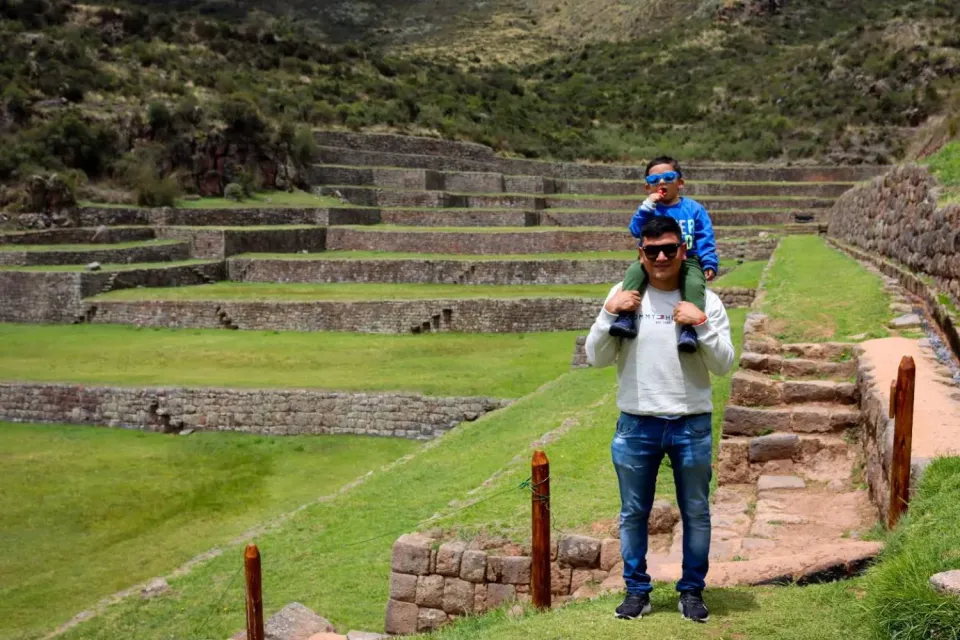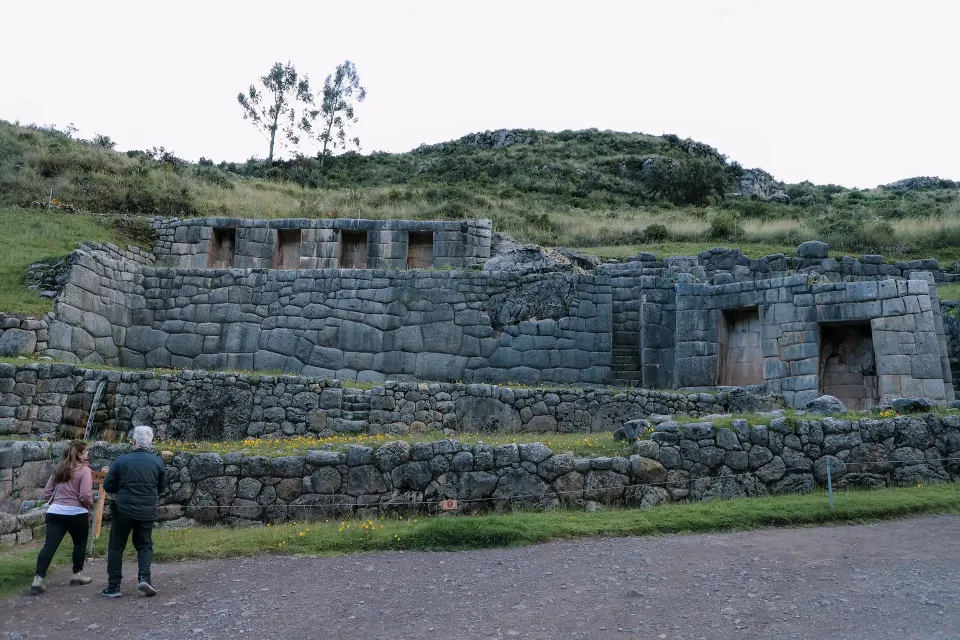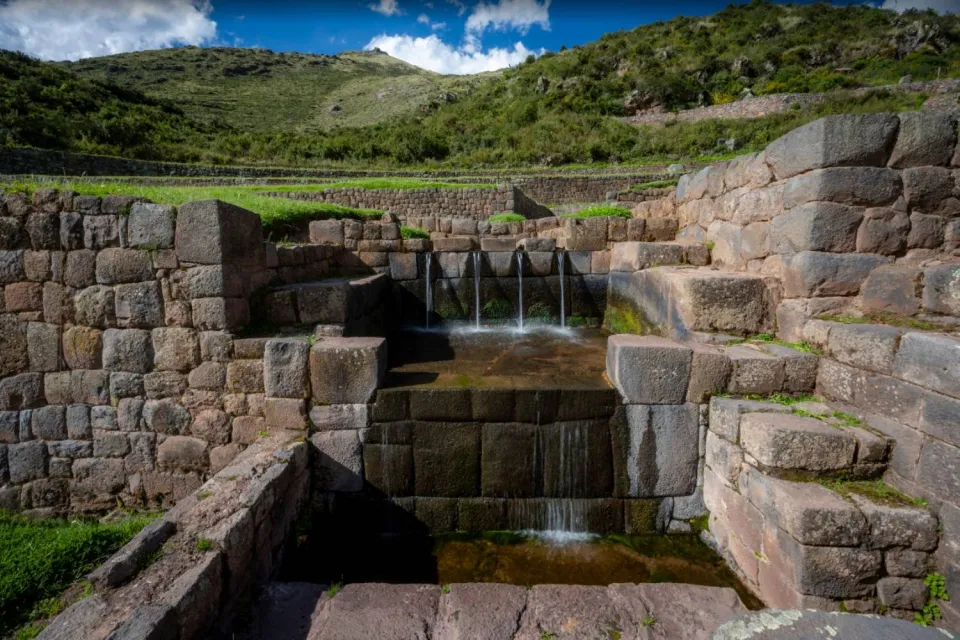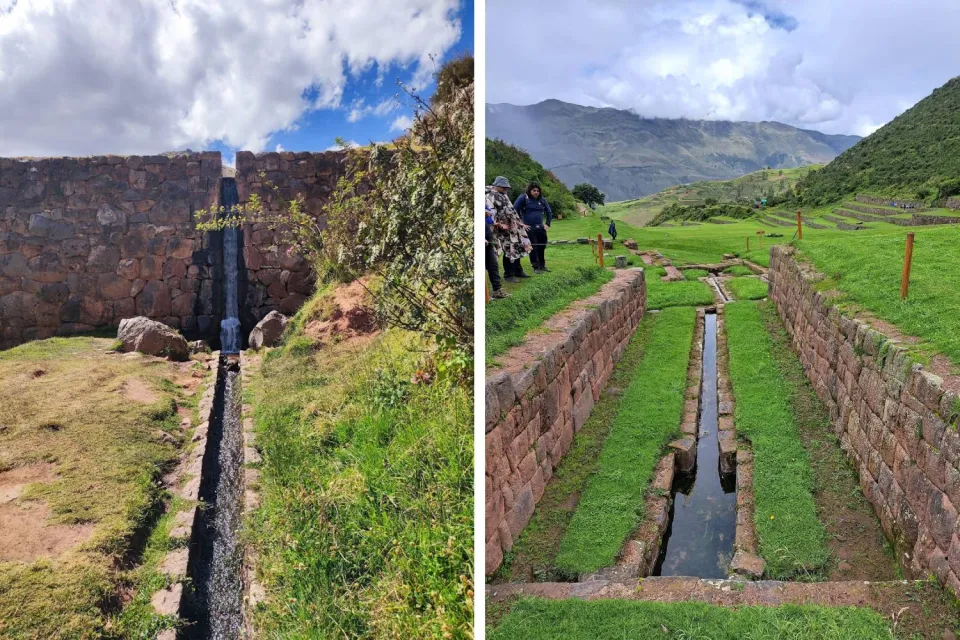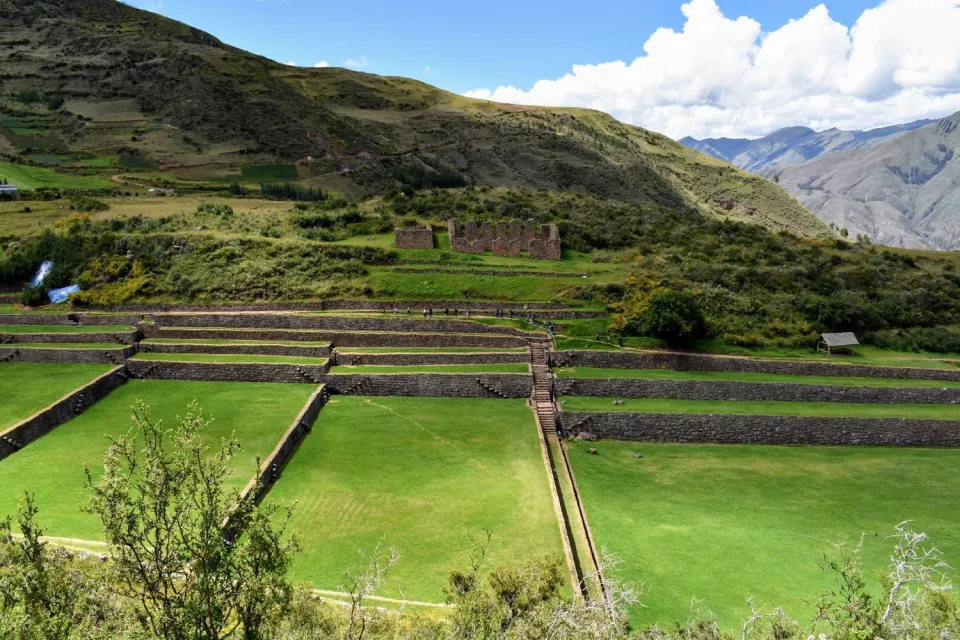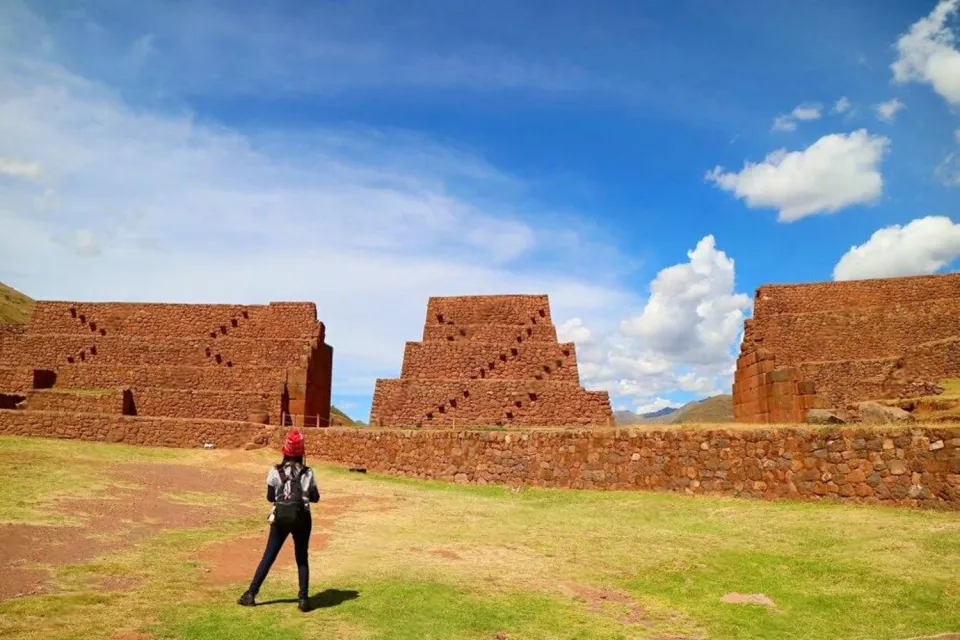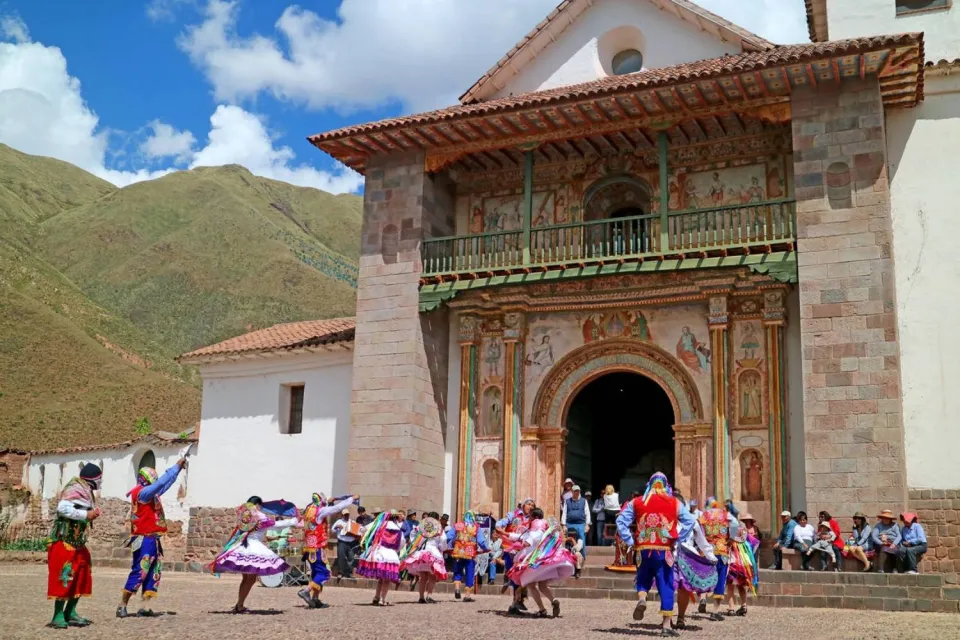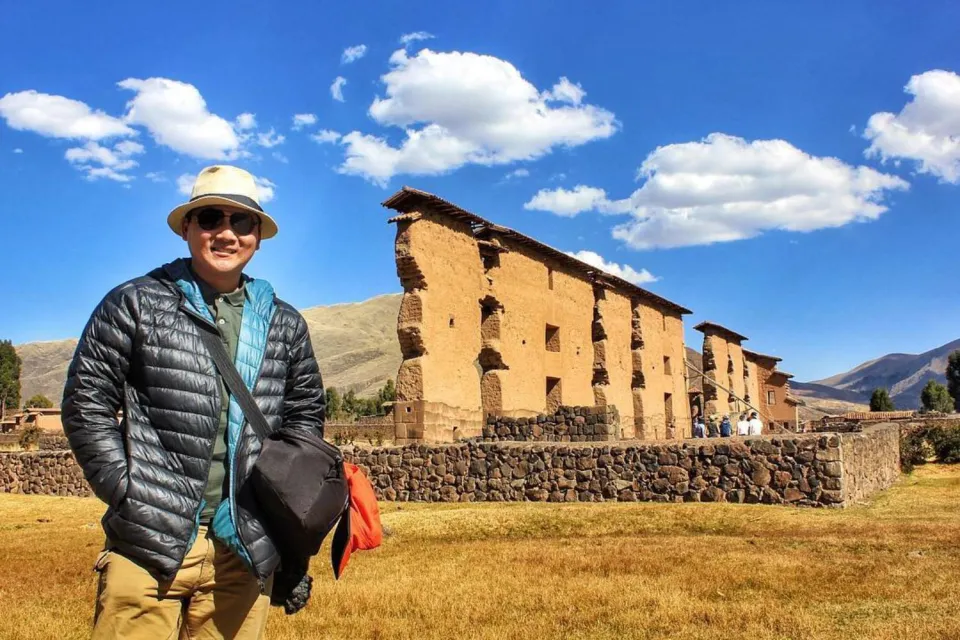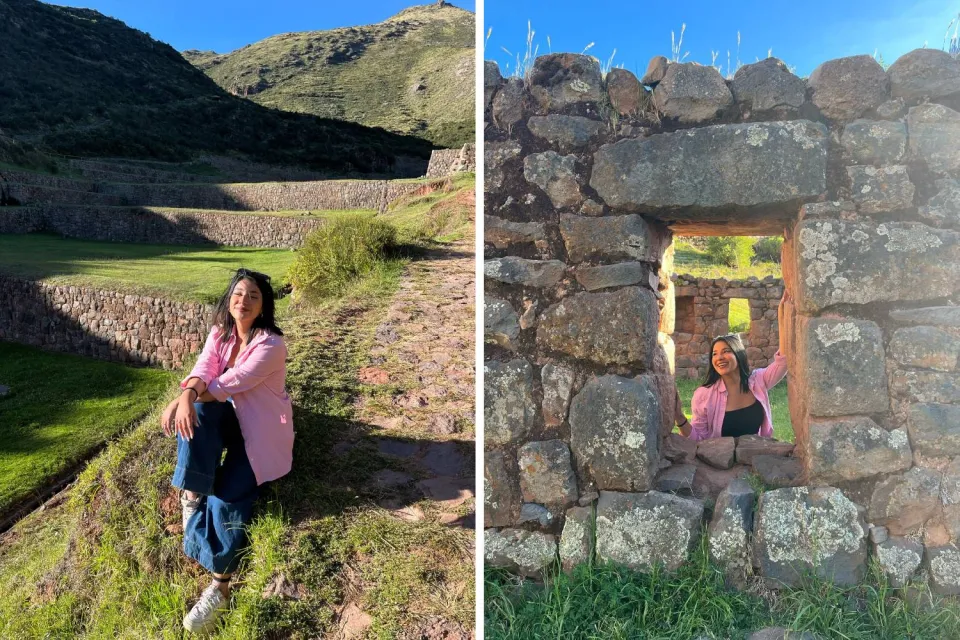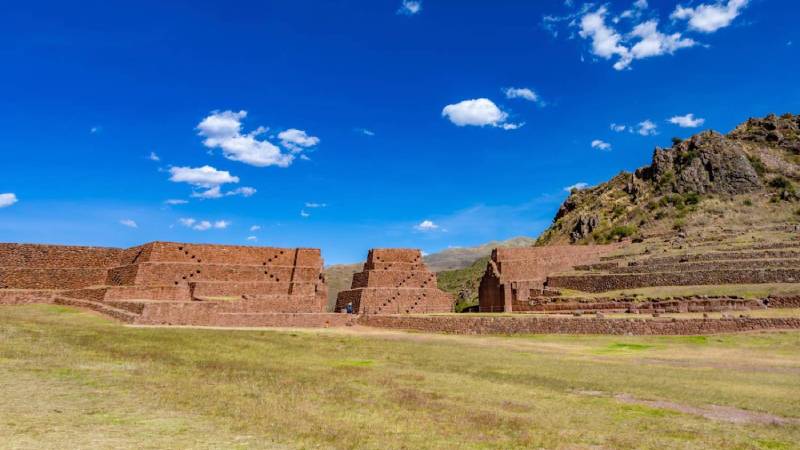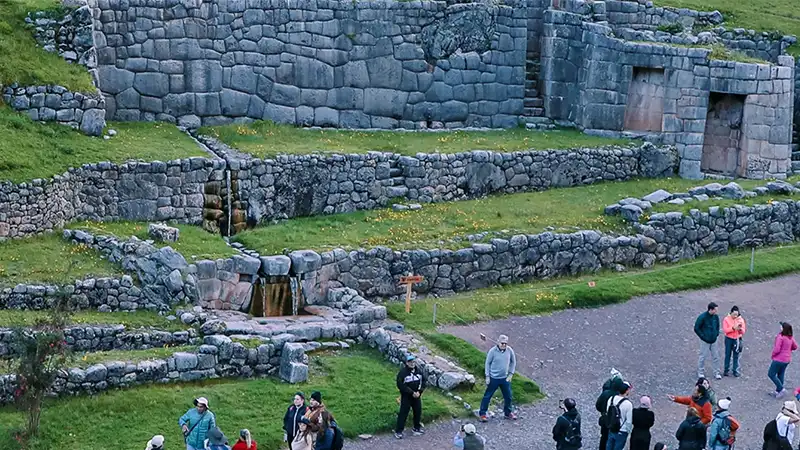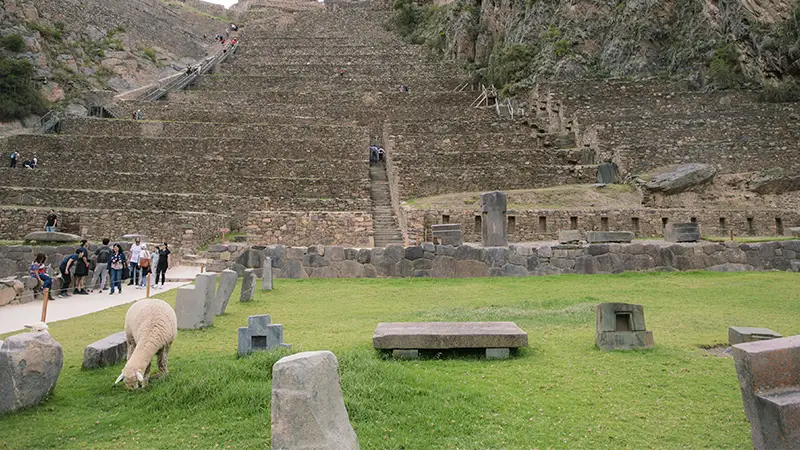Imagine walking through a place where water flows with the same perfection as it did centuries ago, and still continues to fulfill its mission.
This is the Tipón archaeological park, a site that shows us how the Incas took advantage of nature to create a hydraulic system so perfect that it continues to operate to this day. Do you dare to explore its canals and imposing terraces?
What is Tipón archaeological park?
Tipon is an Inca archaeological center located in the South Valley of Cusco, famous for its complex system of terraces, canals and water sources.
This site reflects the mastery of the Incas in hydraulic engineering and is considered the greatest hydraulic work of their civilization.
Beyond its agricultural function, it is believed that Tipon was a ceremonial center dedicated to water, a sacred element in the Andean cosmovision.
In addition, this place served as a residence for the Inca nobility, including the royal family.
Why is Tipon a hidden treasure?
Its hydraulic legacy
It houses one of the most sophisticated hydraulic systems that the Incas created to optimize agriculture and guarantee water supply to their communities.
In Tipón, you can see how the Inca Empire took advantage of the topography of the site to build canals, aqueducts and fountains, through which water still flows today.
This demonstrates the amazing precision and functionality of their design, which remains an example of the advanced engineering of the Incas.
Its water canals
One of the most outstanding features of Tipón is its system of agricultural terraces that, in conjunction with the water canals, served to cultivate crops at different altitudes.
This system allowed the Incas to adjust the flow of water according to the needs of each level of cultivation, creating a perfect microclimate for a wide variety of crops.
The water channels, designed with an exact inclination, still transport water from nearby springs to the agricultural fields, a clear example of the mathematical precision that the Incas applied in their architecture.
It is outside the traditional tourist circuits
Compared to other tourist sites in Cusco, the tipón archaeological park does not receive as many visitors, which means that it is not crowded with tourists.
This allows you to enjoy the visit with more tranquility and without the typical agglomeration of other popular destinations such as Machu Picchu or Ollantaytambo.
In Tipon, you can tour its impressive structures at your own pace, taking your time to admire every detail and capture the photos you want, without rushing.
What does the term Tipon mean?
According to Peruvian historian Luis Antonio Pardo, the term Tipon comes from the Quechua “Timpuj”, which is interpreted as “place of boiling”.
This name was given in reference to the water springs of the site, whose jets gush with such force that they seem to be boiling.
Other researchers suggest that the expression “place of boiling” could refer to the large number of people who gathered in this place.
Another interpretation of the name is that Tipón comes from the Quechua word Tiyay, which means “to sit”.
This would refer to the agricultural terraces of the site, where people "sat" to work the land.
History of Tipón
The Pinahuas (Pre-Inca period)
Before the arrival of the Incas, Tipón was a settlement of the Pinaguas, a group belonging to the ancient kingdom of the Ayarmacas.
This region was key for agriculture, thanks to its natural system of rivers and springs.
Inca Period (Tipon under Inca rule)
During the Inca expansion, Manco Inca conquered the Pinaguas, turning Tipon into an imperial property.
It is believed that the Inca Wiracocha ordered its remodeling to honor his father, Yawar Huaca, after his ascension to the throne, since at that time Tipon was the royal residence.
Years later, the Inca Pachacutec reorganized this site, transforming it into one of the most impressive structures of Inca architecture. This remodeling took place after the victory of the Incas over the Chancas.
Tipon under Spanish rule
After the arrival of the Spaniards, Tipon passed into the hands of the colonizers and became part of the Quispicanchis hacienda, also known as "Glorieta".
Later, it became an important center of textile and agricultural production.
Tipón as an archaeological site
In 1984 it was declared an Archaeological Park, recognizing its importance and seeking to preserve its infrastructure and vestiges of the Inca civilization.
Today, Tipon is an archaeological site of great historical and cultural importance, attracting travelers and scholars from all over the world. It is part of the tourist circuit of the Southern Valley of Cusco
What is the connection between Tipon and Tambomachay?
Tipon and Tambomachay are related because both archaeological sites share hydraulic characteristics, functions and both date back to the Inca period.
Similarities
Both sites stand out for being advanced water systems. It is very likely that they were used for ceremonial purposes related to water, which was considered a sacred element.
Some historians suggest that Tipon and Tambomachay may have been part of the same network of water-related sites connected by the Inca trail.
In addition, both structures are located quite close to the city of Cusco.
Differences
Tipon is famous for its network of canals and aqueducts that still flow, while Tambomachay, known as the "bath of the Inca", is a complex dedicated to water and its cult, with canals and fountains that reflect the same hydraulic mastery.
While Tipón was used primarily for agriculture and food production, due to its system of terraces, canals and aqueducts, Tambomachay has a more ritual and ceremonial function, with water fountains that are believed to have been intended for religious or purification purposes.
Both sites reflect the deep connection the Incas had with water and their ability to harness it in different contexts.
Location and how to get there
Tipón archaeological park is located in the province of Quispicanchis, district of Oropesa, 27 km southeast of Cusco.
It is accessed by the Cusco-Urcos highway, taking a detour at kilometer 18, passing through the town of Choquepata.
Transportation by bus to Sicuani
From Cusco, go to Avenida Huayruropata, where buses leave for Sicuani. Buy a ticket and tell the driver that you want to get off at Choquepata, the entrance to Tipon, located in the district of Oropesa.
The trip takes approximately 40 minutes. When you get off, cross the road and you will find available collective cabs that will take you to the entrance of the archaeological park. The price of these collective cabs is normally 5 to 10 soles.
Public bus transportation
If you are in Cusco, go to Avenida La Cultura and take a public bus to Tipon. Before boarding, confirm with the driver or the ticket collector that the bus goes to the entrance of the archaeological site.
The cost of the ticket is 2 soles. Upon arrival, you will have to take a collective cab, as mentioned above, to get to the entrance of the archaeological park.
Private transportation
In Cusco, there are cab applications where you can request a vehicle to take you directly from your hotel to the entrance of the Tipón archaeological park.
You can also choose to rent a car if you prefer more independence in your trip.
Organized tours
If you are looking for comfort and speed, consider taking a tour to the South Valley with the agency of your choice. This way, you will only have to relax and enjoy the tour.
With us, a specialized guide will explain the incredible Inca hydraulic engineering in Tipon.
In addition, the tour usually includes a visit to Pikillacta, a pre-Inca city of the Wari culture, and the famous Sistine Chapel of America, in Andahuaylillas.
What attractions to see in Tipon?
Agricultural Terraces or terraces
The archaeological complex of Tipon stands out for its 13 terraces in the form of "U", arranged in a staggered manner and accompanied by water channels and cantilevered stairs.
These terraces were built with stone walls filled with earth, creating level surfaces ideal for agriculture.
Their design allowed them to retain moisture, a key strategy for adapting to the dry climate of the Andes.
Here, the Incas cultivated a variety of crops, optimizing the use of water and land to ensure agricultural production.
Main Fountain or ceremonial fountain
Considered a jewel of Inca hydraulic engineering, the Tipon fountain channels water from a natural spring located in a volcanic rock, distributing it in four symmetrical falls.
The water, which still flows constantly, remains clear and pure, demonstrating the precision of the Inca system.
Its function was multiple, serving for domestic supply, crop irrigation and, possibly, with a ceremonial purpose linked to the cult of water, a sacred element in the Andean cosmovision.
Inca Aqueduct
A system of canals 60 meters long and 4.5 meters high that carried water from the Pukara River to the terraces and ceremonial plazas.
In addition, the aqueduct has a ramp and stairs, designed to facilitate access to the highest areas of the Tipón archaeological park.
Intihuatana
A sacred altar in the form of a truncated pyramid, where the Incas performed ceremonies related to the sun and water.
It is located north of Tipon, surrounded by the ceremonial plaza, subway canals and water fountains with large courtyards.
Ceremonial Plaza
A large U-shaped space with trapezoidal niches, used for religious rituals and social activities.
It is built with fine masonry, using andesite stone, and is located next to the aqueduct.
Perimeter Wall
A 5 km long wall surrounding the archaeological site, with a height of between 5 and 10 meters, built for defensive purposes.
Inka Kankas or royal enclosures
It is a small urban space where the Inca nobility resided. Its enclosures still preserve niches, windows and a connection with the stairs, located near the courtyard.
From this point, it was possible to supervise and have a panoramic view of the entire archaeological site.
Sinkuna kancha
It is located southwest of the platforms, on a crescent-shaped hill. This sector was the security center of Tipon, from where the entrance to the complex was guarded.
It is distinguished by the presence of rectangular enclosures with trapezoidal niches and a shared courtyard, whose construction differs from the others, since it is made with polygonal masonry pillowed.
Its function was military, and it is estimated that it could have housed up to 50 people.
Hornopata
It is a small pre-Hispanic circular structure, used as a kiln for firing ceramic objects produced by the Inca workshops in the area.
It was discovered during the last excavation in 2023, where a large amount of Inca ceramic fragments were found, evidencing its use at the time.
Qolqas of the Raqui church
They are rectangular warehouses with ventilation ducts at the base, designed to preserve fresh food for a longer period of time.
These warehouses stored products such as corn, potatoes and other crops, which were then distributed among the population.
Tips and recommendations to visit Tipon: climate, prices and more
Climate in Tipon
The climate in Tipon is temperate, with temperatures between 21ºC and 28ºC during the day and between 7ºC and 10ºC at night.
Tipon has two distinct seasons:
- Dry season: Sunny days and cool nights, with a more stable climate and clear skies.
- Rainy season: More vegetation and probabilities of rain, with more temperate temperatures both day and night.
Recommendation:
The best time to visit is from April to October, when there is less rainfall.
Flora and Fauna of Tipón
In the archaeological park you can find plant species such as the Qiswar, Tancar, Chachacomo, Pata Kiska and Paja Brava.
Among the animals are the skunk, puma, the weasel, the Andean partridge and the wild cat.
How much does the entrance fee cost and what are the opening hours?
To enter the tipón archaeological park, you can purchase your ticket through the Integral Cusco Tourist Ticket or Partial Cusco Tourist Ticket II.
Where to buy tickets?
Currently, they do not sell these tickets online, but you can buy them at:
- COSITUC Office: Av. El Sol 103, Galerías Turísticas, Cusco (Hours: every day from 7:30 a.m. to 6:00 p.m.).
- Admission to the tipón archaeological park: Available at the entrance of the site.
How much does the ticket cost?
- Integral Cusco Tourist Ticket, has a cost of 130 soles for foreign tourists and 70 soles for Peruvians
- Partial Cusco Tourist Ticket II, has a cost of 70 soles for foreign tourists and 40 soles for Peruvians
University students and children from 10 to 17 years old of both foreign and Peruvian nationality have discounts. Children under 9 years old have free access
Finally and very important, the opening hours of the tipón archaeological park are from Monday to Sunday from 8:00 am to 5:00 pm
Curious fact:
The Cusco Integral Tourist Ticket is the most complete option, since it allows access to multiple archaeological sites and is valid for 10 days.
On the other hand, the Partial Cusco Tourist Ticket II is a specific circuit within the integral ticket, with a validity of 2 days.
What to bring?
- Your identity documents such as ID card or passport along with your entrance ticket
- Cameras and cell phones with full battery
- Bottle of water and snacks to go with
- Hat, sunglasses and sun block
- Comfortable and non-slip trekking shoes
- Comfortable clothes to be able to walk inside the park
- Cash, preferably in small denominations
Recommendations
- Acclimatize a day or two prior to your visit in Cusco
- Be careful when visiting in rainy season you can slip
- Do not climb on the walls or water sources
- Do not bathe in or enter the water sources, as authorities prohibit it.
- Do not consume alcoholic beverages in the interior of the park. inside the park
- Wear a rain poncho when visiting during the rainy season
- You cannot fly a drone over the park unless you have authorization
- Take the South Valley Cusco tour for the full experience
- Enjoy a Chicharrón or baked guinea pig near Tipon
Nearby attractions
Cruzmoqo
It is located at the top of the tipón archaeological park. Its name comes from Quechua and means “summit where there is a cross”.
From Cruzmoqo there is a panoramic view of the surrounding area, including Tipon. Experts believe that it may have served a ceremonial function as a huaca or a space for observation.
In addition, they discovered a collection of petroglyphs with geometric shapes, such as double spirals, arrows, dotted lines, and small cavities, which reinforces its importance within the Inca context.
Pukara
The experts consider Pukara one of the first Inca settlements in Tipon. It is located to the north of Intihuatana, approximately 900 meters to the northeast.
In this area, they developed an urban sector for the Inca nobility, with fine masonry enclosures and a strategic distribution.
Surrounded by numerous cultivation terraces, Pukara reflects the advanced Inca agricultural knowledge, designed to optimize the use of water and food production on the mountain slopes.
Andean World Zoo
The Andean World Zoo dedicates itself to the conservation and exhibition of the typical fauna of the Peruvian Andes.
Here, visitors can closely observe emblematic species such as the Andean condor, spectacled bears, vicuñas, alpacas and pumas, among other native animals.
In addition, the zoo seeks to educate about Andean biodiversity and the importance of protecting its ecosystem.
Huasao Wetland
The Huasao Wetland, located in the South Valley of Cusco, stands out for its biodiversity and its ecological wooden sculptures inspired by characters from popular culture, such as Groot and Ents.
This space is a refuge for birds and other local species, in addition to being an ideal destination for ecotourism and outdoor recreation.
Huacarpay Lagoon
Huacarpay Lagoon is a natural wetland located within the Lucre-Huacarpay Sanctuary. It is an ecosystem rich in biodiversity, home to numerous species of migratory and local birds.
Surrounded by Andean landscapes, this lagoon is an ideal destination for bird watching, ecotourism, and nature photography.
Pikillacta
Pikillacta is an impressive pre-Inca archaeological site belonging to the Wari culture (500-1000 AD).
It stands out for its urban planning, with straight streets, stone and adobe buildings, and a complex system of canals. Experts believe it was an administrative and ceremonial center.
Its name in Quechua means “city of the fleas”, although its true purpose remains a mystery.
Andahuaylillas Church
The Andahuaylillas Church, known as the "Sistine Chapel of America", is a jewel of colonial art.
Built in the 16th century, it stands out for its impressive architecture and its interior decorated with frescoes, gilded altarpieces and baroque details.
The church is an important religious and cultural center, reflecting the fusion of indigenous and colonial traditions.
The temple of the god Wiracocha (Raqchi)
The Incas built Raqchi as an archaeological site, famous for its impressive temple dedicated to the god Wiracocha.
This complex features a large rectangular platform, adobe walls and circular columns supporting what was once a wooden roof.
The Inca Empire likely used Raqchi as an important ceremonial and supply center, and it also contains storage structures and dwellings.
Why visit the tipón archaeological park?
The tipón archaeological park is a jewel of Inca hydraulic architecture, where you can admire impressive agricultural terraces, water channels in perfect working order and ceremonial temples.
It also offers:
- Spectacular landscapes, ideal for photography.
- Advanced engineering, which demonstrates the Inca wisdom in water management.
- Connection with history and culture, in a less crowded site than other tourist destinations.
- Outdoor experience, perfect for those who enjoy trekking and nature.
Visiting the tipón archaeological park is to discover an ancestral legacy that continues to surprise to this day. Don't miss it!
Frequently Asked Questions about tipón archaeological park
- Do I need a guide to visit Tipon?
No, but it is recommended. A guide will help you understand the history, hydraulic engineering and cultural significance of the site, enriching your experience.
- How long does it take to visit Tipón?
The tour of Tipón can take between 1 and 3 hours, depending on the visitor's pace and the areas he/she wishes to explore.
- Is Tipón suitable for people without trekking experience?
Yes, Tipón is suitable for people with no trekking experience. Its trails are accessible and of moderate difficulty, so you can walk calmly and enjoy the scenery.
- Is flying drones allowed in Tipón Archaeological Park?
No, the authorities forbid flying drones over Tipón Archaeological Park unless you have a permit from the Ministry of Culture.
- Are there stores and restrooms near tipón archaeological park?
There are no stores or restrooms at the entrance or inside the tipón archaeological park.
- Can visitors hire local guides directly at the entrance of Tipon?
Yes, at the entrance of Tipon you can hire local guides directly.
- Who first studied the tipón archaeological park?
Julio C. Tello was the archaeologist who studied the tipón archaeological park at the beginning of the 20th century in 1937.
- Where to eat near Tipon?
Tipón is famous for serving "cuy al horno" (roasted guinea pig). Some recommended restaurants are:
- Chicharronería El Dorado
- La Hacienda del Tío Juan
- La Casona del Valle Sur
- Are there hotels near Tipón?
There are no hotels in Tipon, but you can find accommodations in the city of Cusco, which is the closest and most convenient option.

